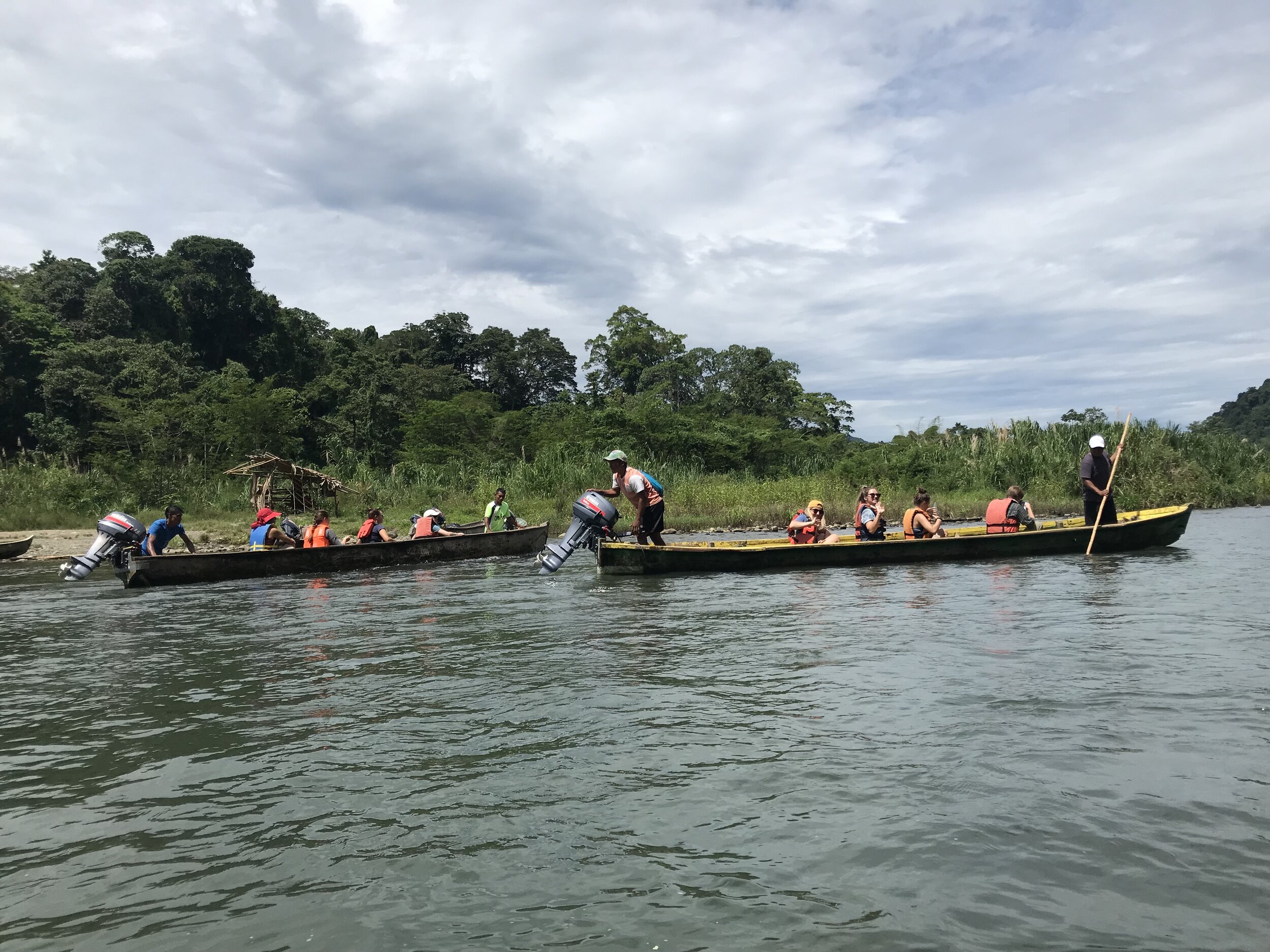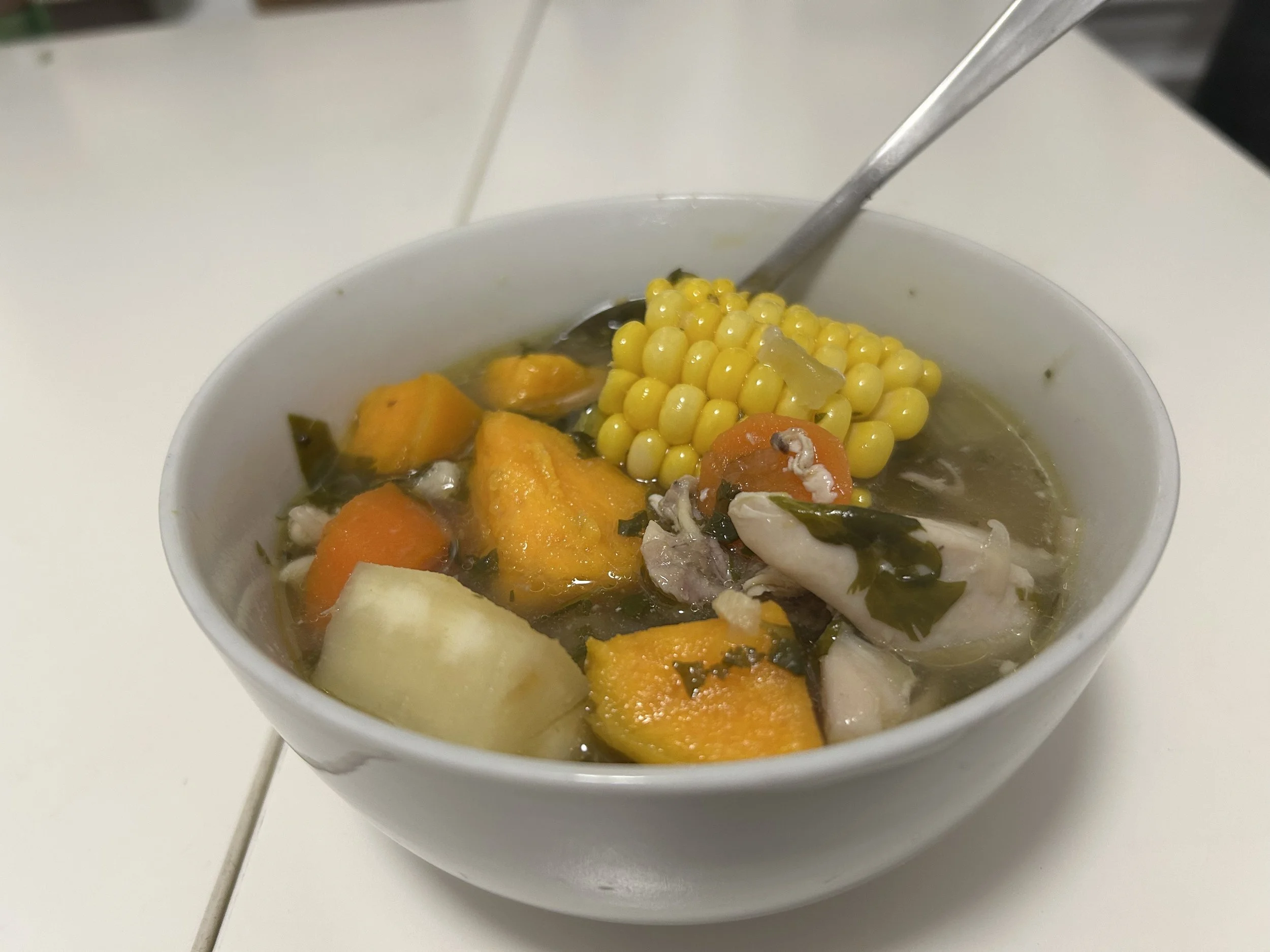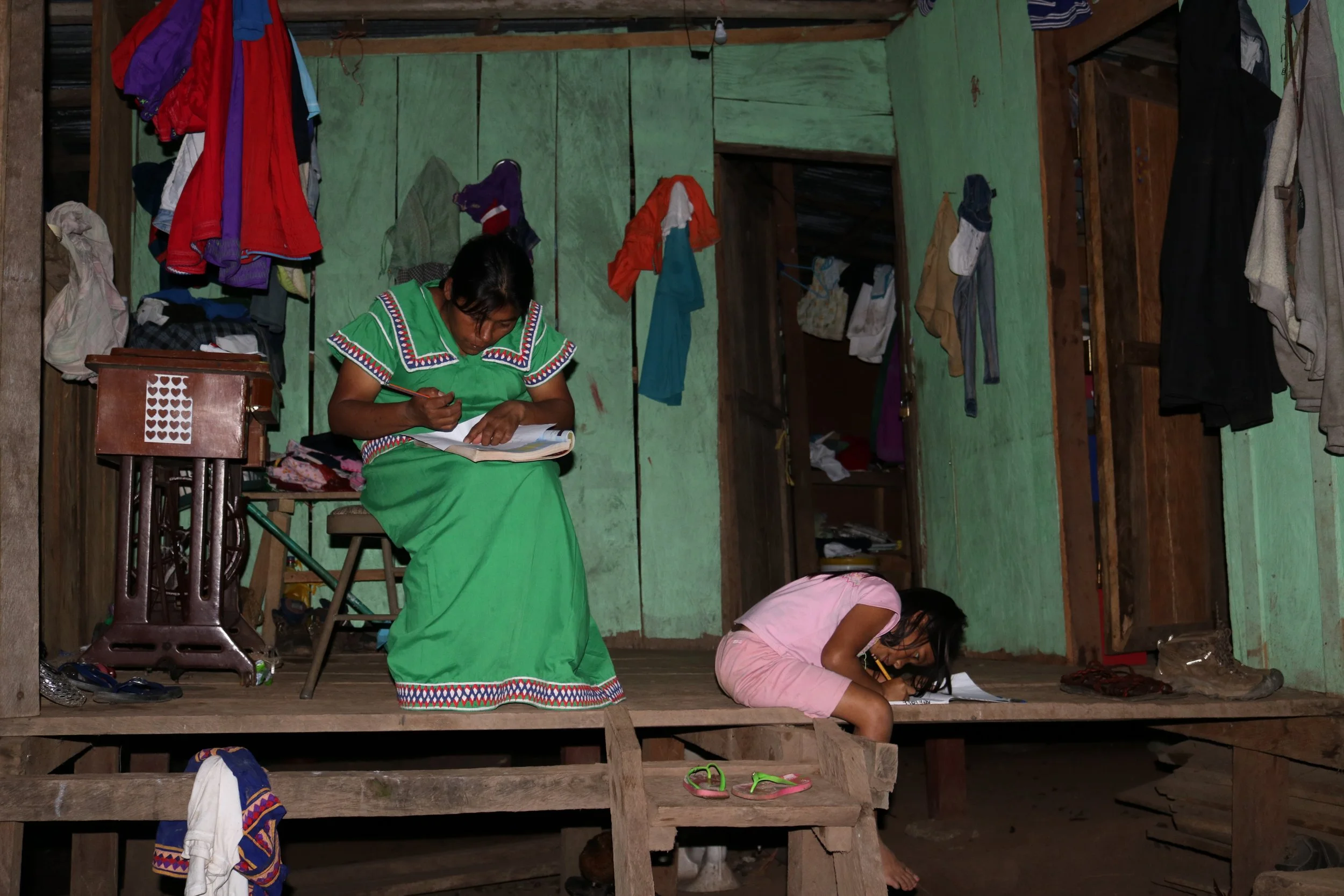This guest post was written by Morgan Oestereich, an Environmental Studies major at Davidson College, Class of 2021. Morgan is a Bonner Scholar, and is volunteering during her Spring 2020 semester as the Few for Change Communications Fellow. Morgan spent her Fall 2019 semester in Panama with SIT (the School for International Training), and recounts below her experience in the indigenous Naso Territory of western Panama.
Students loaded up onto motorized dugout canoes, about to begin the long journey upstream on the Teribe river to reach Siey kjing. Photo credit: Morgan Oestereich
If you ever have the chance to spend a day or two living a life entirely different from your own, take it.
As September bled into October in 2019, I was able to do just that. One month into my study abroad experience with SIT Panama, I spent two nights in Siey kjing, El Territorio Naso Tjër Di, Panamá.
The trip began with us, a group of fifteen college students, piling out of our taxi-pickup trucks onto the bank of the Teribe River in the Northwestern-most area of Panama, between the Costa Rican border and the province of Bocas del Toro. A fleet of wooden canoes lined the riverbank. My ear, which had been spending the past month slowly becoming accustomed to the sound of the Spanish language, was immediately filled with unknown words spoken with unfamiliar sounds. Aly Dagang, our academic director, introduced us to a multitude of boat captains and community leaders. Before we knew it, we had begun our hour-long journey upstream to reach Siey kjing.
The center of town is marked by the cultural center, from where the picture was taken; the soccer field, which is flooded after an afternoon storm; and the primary school, which is just out of shot. Houses and sheds surround the soccer field. Photo credit: Katie McErlean, Fall ‘19 SIT Panama student
After a few harrowing moments of canoes getting caught in the shallow rapids, unforgettable views of lush forests growing atop eroding rocks, and a 40-minute hike into the forest, we walked into the tightknit community of Siey kjing. Thatch-roofed and tin-roofed wooden houses on stilts surrounded us. The center of town was marked by a primary school and a soccer field. We entered a large covered patio with benches and a stage—the cultural center. Before I could catch up with the whirlwind of three languages being translated amongst each other, I had been assigned my host family for the stay: the family of Sr. Sánchez.
To be completely honest, Sr. Sánchez would not have been my first choice, based on appearance alone. I probably would have chosen a smiling, caring looking grandmother, or a young mom who had brought along her toddler. Sr. Sánchez’s seemingly aloof demeanor intimidated me. However, I am so incredibly grateful that chance put me in the loving, caring, and exceptionally welcoming hands of Sr. Sánchez and his family. The incredible lengths of their hospitality and enthusiasm to share their knowledge and thoughts on their culture will forever stay with me, and here’s why.
Unbeknownst to me at the time of host-family assignments, the Sánchez family was special in a few ways. One, they lived the closest to the center of town. I could watch students enter and leave school each day, and the teenagers play soccer right from the second floor of my home. Two, Sr. Sánchez had two incredibly funny and kind children who will forever hold a place in my heart. And three, Sr. Sánchez was actually a leader in a cultural organization for Siey kjing and the surrounding communities, working to preserve the Naso language, traditional medical practices, dance, song, and other traditions.
Two teenagers from Siey kjing play soccer in the rain while the students in primary school attend class. Photo credit: Morgan Oestereich
The first day in Siey kjing was spent hanging around town, seeing local artisan crafts, being lovingly welcomed to a birthday party, and trying to survive hordes of elementary schoolers who only wanted to tease us. Then, after sunset, we returned to our respective host homes to spend time with our host families.
My most prized possession from my entire abroad experience is two pages in my notebook filled entirely—even crammed into the margins—with words written in Spanish, English, and Naso. My host brother and sister would spend hours sitting with me on the floor, bonding over our shared efforts to be bilingual. You see, while I was trying to learn Spanish, my host siblings, and the other youth of Siey kjing, were trying to keep the Naso language alive. We may have all heard of dying indigenous languages. This was my first time watching such a language in the midst of its rebirth. Finally given permission to teach it in schools, Siey kjing was a community desperately trying to keep their language alive. So, we would sit on the floor and think of words in Spanish. They would write and teach me to say that word in Naso, and I would do the same in English. Sometimes, they’d have to ask their parents for a word in Naso. Sometimes, I’d have to look up what a Spanish word meant. We’d tell stories about los alacranes (scorpions) that stung my host sister or las ranitas (little frogs) which I adore. We spent hours writing under the light of the dim, red flashlight that another SIT student had brought.
Chickens take advantage of the rain to scavenge the soccer field. The house on the left is notably not traditional, as it square and has a tin roof. Photo credit: Katie McErlean, Fall ‘19 SIT Panama student
Sr. Sánchez gave insight on more complex elements of Naso life. El Territorio Naso Tjër Di is unique among Panama’s indigenous groups for a couple reasons. First, which is given away by its name, is that the land occupied by the Naso people is a territory, and not a comarca. Comarcas give indigenous groups autonomous authority over their lands. The Naso do not have this right. Second, El Territorio Naso Tjër Di is a functioning monarchy, led by a King living in the neighboring community of Siey Llik.
The two largest problems Sr. Sánchez spoke with me about were the construction of hydroelectric dams, two so far, on the Teribe River and the Panamanian government’s reluctance to grant the Naso their own comarca.
The unfinished roof to a building under construction. It will one day become a center for teaching Naso youth traditional medicine. Drifting through the rafters is smoke from a burning native plant, which is said to bring you good dreams. Photo credit: Morgan Oestereich
The king is corrupt, he thinks, and keeps for himself the money that the electric companies give him in order to construct dams. It should be given to the community members. They have no running water, no consistent electricity, kids have to go so far away for class once they pass primary school. There are no roads. The dams flood the river and harm the fish and poison the water. The river is the Grandmother and the lifeblood of the community.
Without a comarca there is no power. The Naso people struggle to stay strong without one. They fight so hard and have for over forty years. The government doesn’t think the environment, the area’s rich and diverse rainforests, will stay protected if a comarca is granted. But what about the dams, don’t they disturb the environment? Have the Naso not been living here for hundreds of years, protecting the land? The land is sacred. A comarca will help with its protection. A comarca is needed. We need a comarca.
Sr. Sánchez told me these things under the dim light above the dining table. Things so complicated I couldn’t form the words to respond how I wanted. I could only solemnly sympathize.
But don’t be discouraged. Sr. Sánchez and his family gave me so much hope for the world. Often times, indigenous people are seen as lost. Or primitive. Or maybe they’re not seen at all. But there, on the floor of the Sánchez’s house, or sitting at their table eating traditional Naso dishes, sipping medicinal tea, there’s a family working so hard to preserve what’s theirs and fight for what they deserve. And that’s just one example. My time in the Naso completely revolutionized how I understand the indigenous experience. I’ll admit, and I’m sure a lot of us can, that it’s hard to relate with non-Western cultures sometimes. It goes against what society teaches us and wants from us. But if you’re ever given the chance to spend a day or two living a life entirely different from your own, with someone so genuine and willing to share their story with someone like you who doesn’t understand yet, take it.













